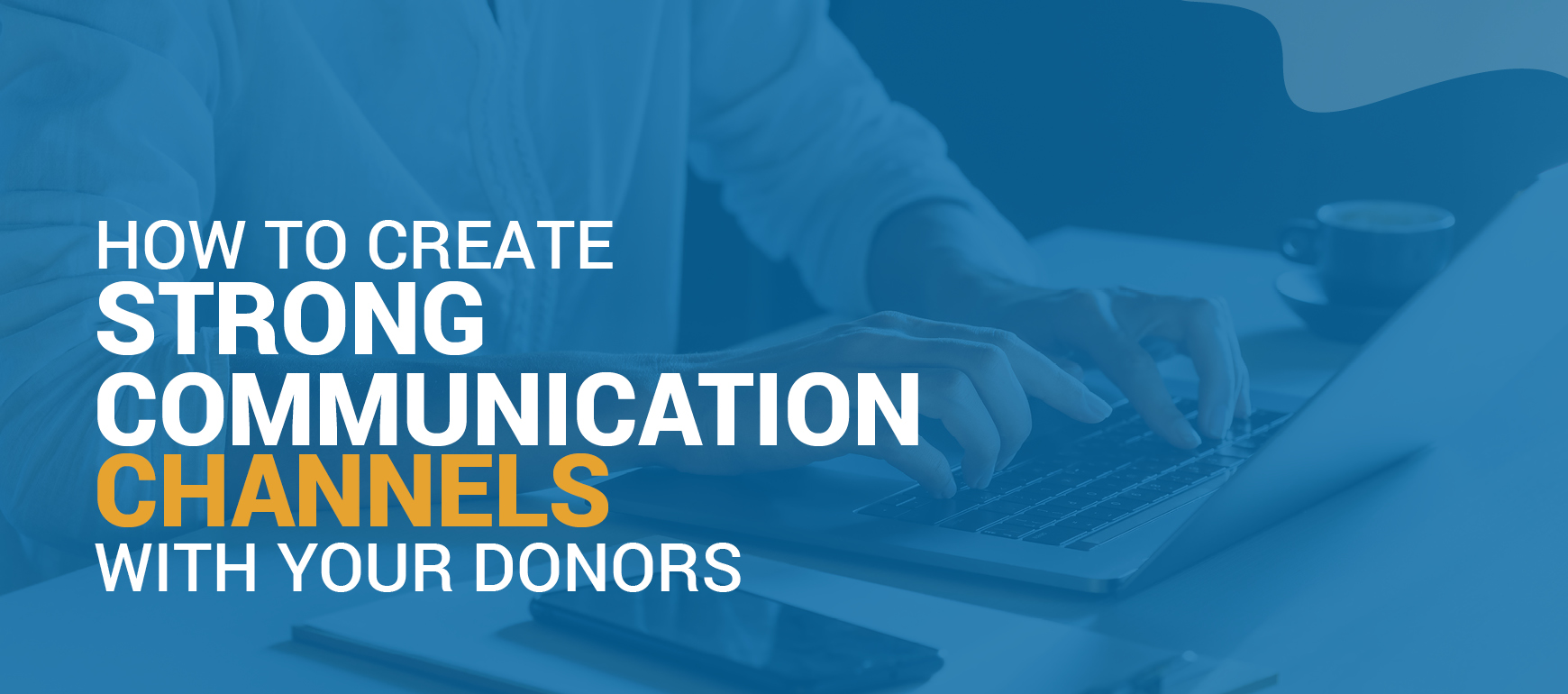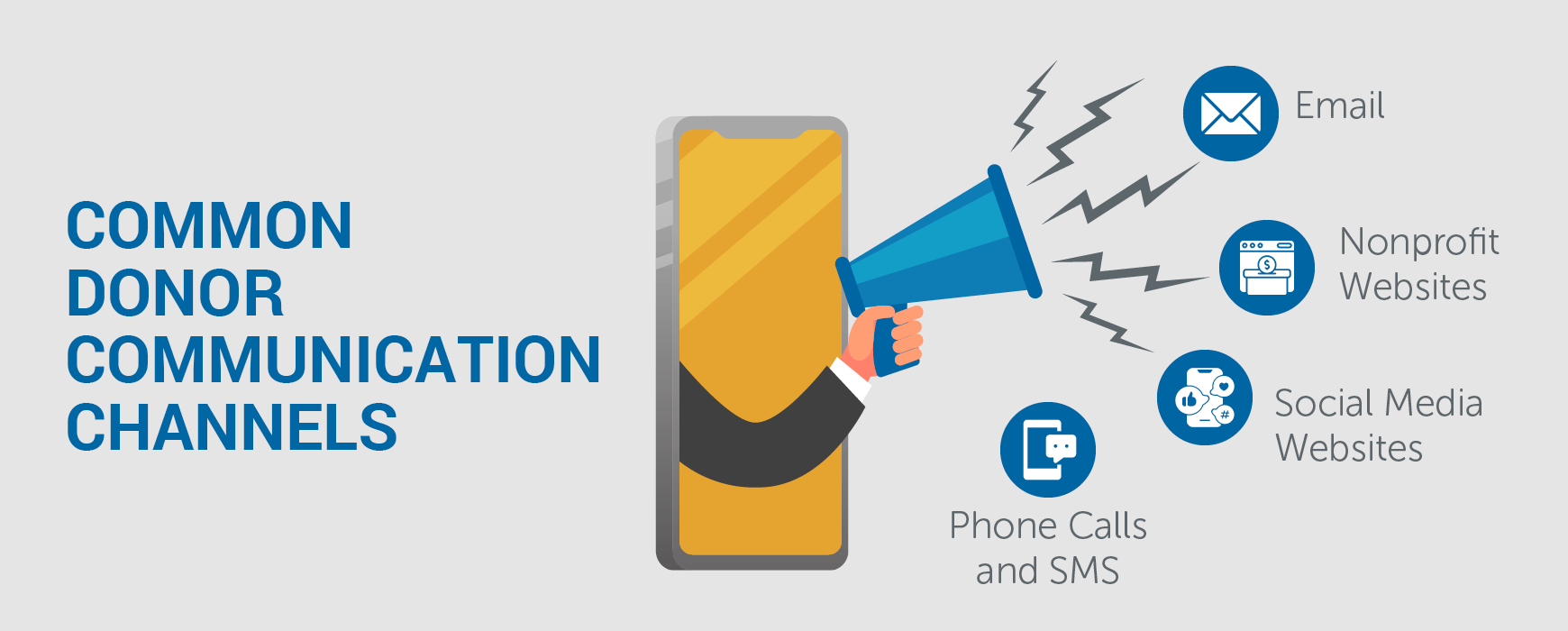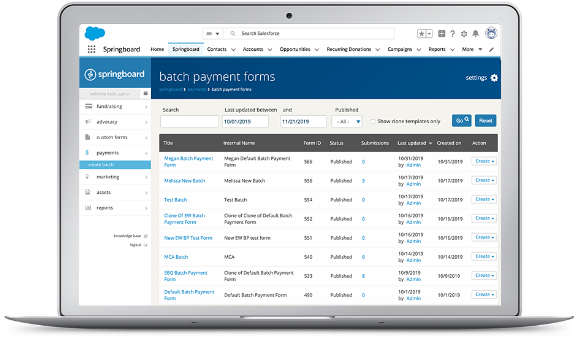How to Create Strong Communication Channels With Your Donors

In a world swamped with endless information, establishing genuine connections with donors is paramount. Communicating with supporters helps retain their support, and doing so effectively takes more than occasionally emailing them or posting social media updates.
Donors expect (and deserve) more from the nonprofits they support. Fortunately, technology makes it easy to personalize donor communications, send relevant updates, and convey appreciation. It’s just a matter of pinpointing the right tools and strategies to facilitate interactions.
As we enter the year-end giving season, we’ll explain tactics for choosing reliable donor communication channels and establishing a regular cadence, helping you develop strong donor relationships that last.
Be strategic with the channels you use.
Nonprofits have seemingly infinite ways to interact with donors. You’ll need to leverage a combination of channels to ensure a diverse, comprehensive approach to donor communication, so you can meet donors where they are and in ways that resonate most with them.

Channel 1) Email
Email marketing is one of the most powerful donor communication channels at your disposal. According to eCardWidget’s donor thank-you email guide, 33% of donors consider email to be the channel that most inspires them to give.
To tap into this channel, design responsive and visually appealing newsletters, fundraising appeals, thank-you notes, and so on. Incorporate these elements to drive open rates and boost the impact of your email outreach:
- An optimized subject line: Aim for 40 to 60 characters and clearly explain the purpose of your message. Personalize your subject line with the recipient’s name if your marketing tools allow that, too!
- Engaging visuals: A picture or graphic can go a long way in communicating your message. You might feature the constituent whose story you’re telling, behind-the-scenes glimpses of a project the donor funded, or an infographic showing your organization’s impact over the year. Get creative with your formatting to make them stand out, too. For example, you might send event invitations or thank-you notes with an eCard platform.
- Call to action: Every message you send should have a clear purpose. Encourage the recipient to take a specific action, whether that’s donating, registering for an event, or signing up for a volunteer opportunity.
Among a sea of emails, yours should stand out in donors’ inboxes. Take the time to create personalized, engaging emails, and this will become a reliable donor communication channel for your organization.
Channel 2) Website
Your nonprofit’s website houses everything from mission information to your donation form to involvement opportunities. Use it to publish donor spotlights, updates, upcoming events, and donation or volunteer opportunities.
Make sure it’s accessible and mobile-responsive, too. That way, anyone who comes across it can interact with your content and get involved.
Channel 3) Social Media
This channel is a must for any nonprofit, especially if you’re trying to appeal to Millennial and Gen Z donors.
Regularly provide updates, call attention to special projects that need support, and share involvement opportunities on social media. To integrate this channel into your regular donor communications, test out strategies like the following:
- Share behind-the-scenes content showcasing the impact of donations.
- Engage donors with interactive posts and polls.
- Recognize donors publicly with their consent.
- Post user-generated content where donors share their reasons for supporting your cause.
- Respond to and like followers’ comments.
Social media platforms like Facebook, Instagram, X, and TikTok open the door to more two-way communications with donors. Figure out which platforms your donors actively use and encourage them to engage with your nonprofit.
Channel 4) Phone Calls and Texts
These days, almost everyone has a phone, making it a smart way to stay in touch with donors. Whether you focus on texting or calling, here are a few ways you can add this channel to your donor communications:
- Make thank-you calls. Call any mid-sized or major donor who prefers chatting on the phone. You can personally thank donors and provide personal updates on projects they’ve supported. You’ll also be able to gather feedback directly from them.
- Invite donors to support an event or project. This is a great way to involve them in a specific initiative or an event. They’ll be much more likely to attend or donate when you personally invite them!
- Host a text-to-give campaign. Backed by fundraising technology, you can encourage donors to text your campaign’s keyword to an assigned number associated with your nonprofit. Depending on your platform, donors will either click a link to visit your mobile donation form or text back the amount they wish to donate.
- Send urgent updates via text. Keep your donors in the loop by texting them event reminders and time-sensitive fundraising appeals. For example, let’s say your disaster relief organization wants to fundraise for a recent earthquake. You can text to encourage donors to visit your website to learn more or donate to aid those impacted.
Your supporters use their phones daily, so keep this platform in mind when fleshing out your donor communication strategy. Know that you’ll likely need dedicated technology to help facilitate texting, though.
Segment your donor communications.
Your donors are all different, and your communications with them should reflect that. Segmentation is the process of dividing your entire donor list into smaller, more specific groups based on shared characteristics or preferences. Backed by intuitive marketing software, here are a few ways you can segment your donors:
- Group donors based on donation tier. That way, you can send appeals that align with their giving preferences.
- Segment by engagement level (e.g., one-time donors, recurring donors, or long-term supporters). You can tailor your messages to resonate with the frequency and length of their support.
- Divide donors based on their preferences or interests in your mission. This will enable you to send communications about specific initiatives they care about.
- Use donor demographics (e.g., age, gender, or location) to tailor messages. For example, NPOInfo’s demographic appends article explains that an advocacy organization may want to verify people are of voting age, or another nonprofit may want to group donors based on income level to tailor fundraising asks.
- Segment by preferred communication channel, so you can increase the likelihood that they’ll see your messages.
- Group donors based on their corporate giving eligibility. For example, knowing whether donors are eligible for matching gifts allows you to follow up and drive more revenue through corporate giving.
You’ll need to use marketing software that enables segmentation to tailor your outreach. Doing so will ultimately enhance your donor communications and forge deeper connections.
Develop a donor communication cadence.
Staying connected with donors requires you to reach out consistently and not just during big campaigns like GivingTuesday. You don’t want to go months without contacting them. Conversely, you don’t want to bombard them with countless messages. There’s no quicker way to make them hit that unsubscribe button.
Instead, reach out consistently with messages relevant to their interests. What’s more, don’t over-solicit them — strategize the balance between asking for donations and providing valuable updates.
To develop a strong cadence, consider these timing suggestions:
- Post-donation recognition. Send a personalized thank-you letter within a few days after someone donates. This lets them know you received and appreciate their contribution.
- Event and campaign reminders. Keep your fundraisers, projects, and events top of mind by reaching out to anyone who’s expressed interest.
- Celebrate special milestones. Reward donors for sticking around. You might send a special gift or an eCard for their five-year anniversary to say thanks for their continued support.
- Feedback and engagement surveys. One way to deepen donors’ involvement in your mission is to request their feedback. Encourage them to share their opinions on your programs, how they prefer to engage with your nonprofit, and what initiatives they’d like to learn more about.
From here, pay attention to how your donors respond to your outreach. Doing so will empower you to reach out at optimal times and drive more engagement.
Use the latest donor engagement tools.
Donor-nonprofit relationships are based on shared values and a desire to do good. If your nonprofit wants to focus on the humanity in your donor relationships, using a CRM with baked-in artificial intelligence could help you with the boring segmenting and reporting work, creating more timely, targeted, and effective donor communications.
AI-enhanced donor CRMs offer several key advantages:
- Personalized Engagement: AI analyzes donor data to identify individual preferences, giving history, and engagement patterns, allowing nonprofits to tailor communications for maximum conversion and impact.
- Predictive Analytics: By examining past donor behavior, AI can predict future giving trends, helping organizations proactively engage with the right donors at the right time.
- Optimal Timing: AI can provide timing suggestions for individual donor communications, increasing open rates and engagement.
Recent benchmarks highlight the effectiveness of AI-powered donor CRMs: According to Giving USA, individual giving is growing an average of 5.5% each year. But over the past five years, digital-first organizations have averaged 6.2% growth in giving. And thanks to NextAfter for doing the math for us: Digital-first organizations are growing 12.7% faster than the average nonprofit.
These reports didn't specifically study the use of AI in donor management, stewardship, or communications, but this trend bodes well for nonprofits that take the leap into AI-supported stewardship.
Real-World Applications of AI-powered CRMs
Consider how an AI-powered CRM might enhance a text-to-give fundraising campaign:
- The nonprofit donor management software uses machine learning to analyze past giving data signals.
- Personalized ask amounts are generated for each donor based on giving activity like time of day, device type, giving history, and more.
- Donor conversions go up!
- Follow-up communications can be automatically triggered based on donor responses or lack thereof.
You may be the human intelligence, but the artificial intelligence in your donor CRM can help you focus on creating more meaningful, timely, and targeted communications that your donors will feel on a personal level, not only enhancing your donors' experience but also driving better fundraising results and deepening long-term relationships.
Looking ahead: Start improving donor communications.
By leveraging various donor communication strategies, your nonprofit can ensure that the trust you build is unshakable. Start by referencing the platforms your donors prefer to use and center your outreach around those channels. Aim for a balance between frequency and value in your communications, and pay attention to what your donors respond positively to. By adapting your outreach strategy over time, you’ll ultimately forge better donor relationships to power your mission long-term.

